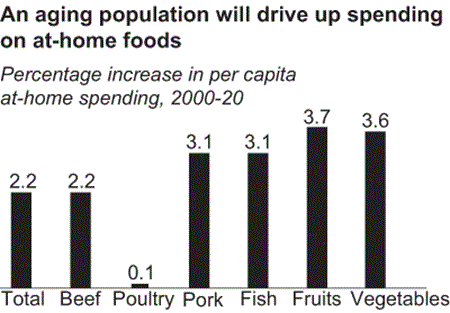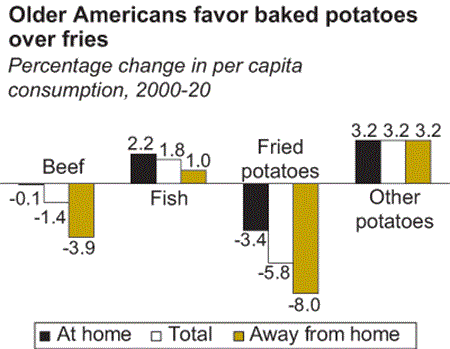Hold the Fries: Older Americans and Food Choices

Increases in average life expectancy and the aging of the baby boom generation are combining to push the share of older people in the U.S. population to historically high levels. The population age 60 and older is predicted to rise from 16 percent in 2000 to 23 percent in 2020. The share of children, by comparison, is expected to drop by 3 percentage points, and the share of adults age 20-59 will drop by 4 percentage points.
Older Americans are less active than younger people, eat less food, dine out less, and have distinct food preferences. These characteristics, in light of population trends, will affect how much Americans spend on food and the types of foods they eat. ERS conducted an extensive study to understand how population growth, income growth, and shifts in other demographics—including aging—will affect U.S. food spending and consumption in 2020. The predicted net effect of all these trends is to increase per capita spending on food away from home by 8.1 percent from 2000 to 2020. By contrast, age-related factors alone, including lower earnings, reduced mobility, more time to prepare meals, and likelihood of eating lunches at home rather than at work, are predicted to reduce per capita spending on food away from home by 1 percent. The age factor will, however, boost at-home food spending by 2.2 percent per person, partially because older people may buy smaller portioned, more expensive products and may have their groceries delivered. These food-at-home purchases also reflect the change in preferences that occurs as people age—older Americans tend to spend more on fruits, vegetables, pork, and fish to eat at home.
Food consumption—in terms of amounts and types—also changes as people age. Though older Americans will spend less on food away from home, they will consume more fish and potatoes other than french fries, both away from home and at home. Older people also eat more vegetables at home. Overall, the age factor alone is predicted to reduce total per capita consumption of fried potatoes, beef, poultry, cheese, sugar, grains, and tomatoes.
Food and Agricultural Commodity Consumption in the United States: Looking Ahead to 2020, by Biing-Hwan Lin, Jay Variyam, Jane E. Allshouse, and John Cromartie, USDA, Economic Research Service, February 2003



